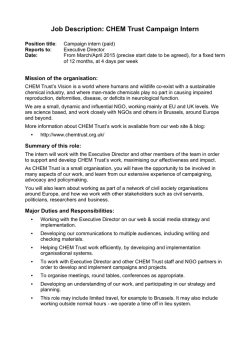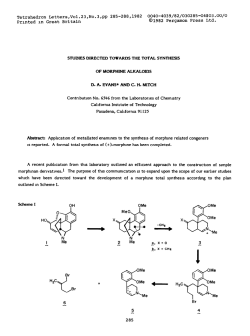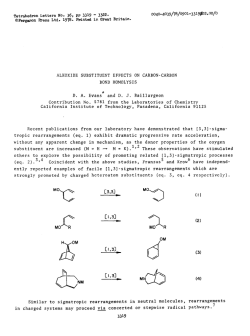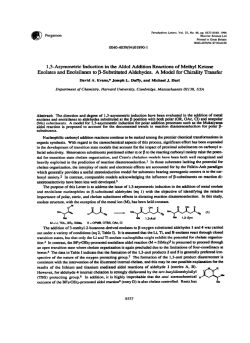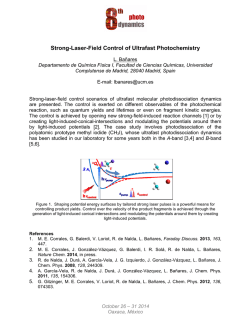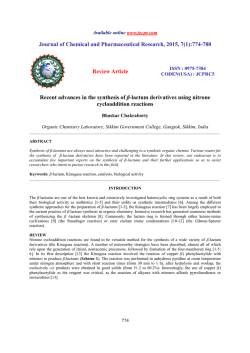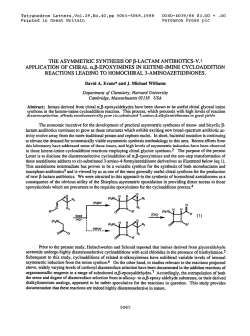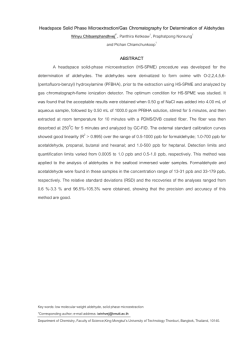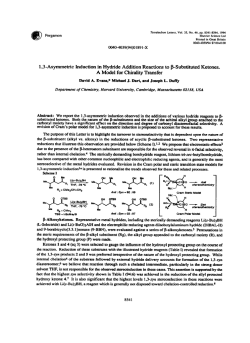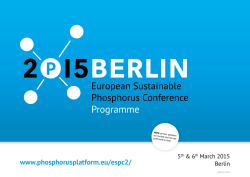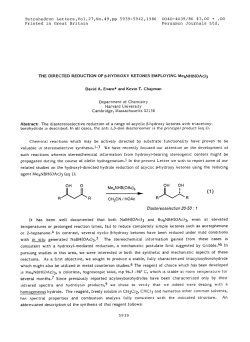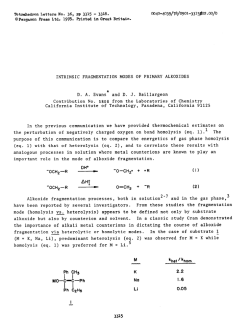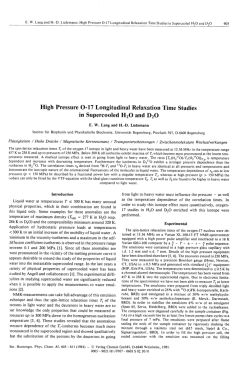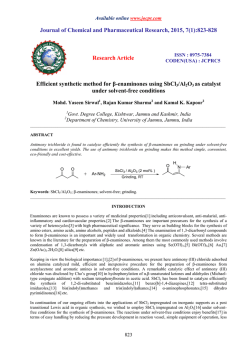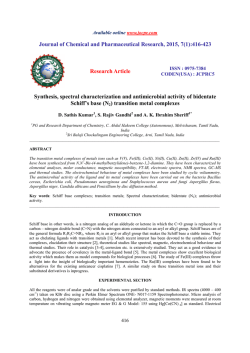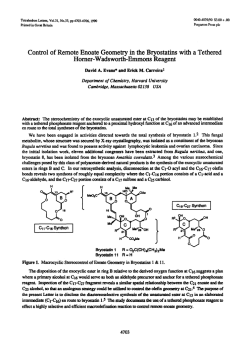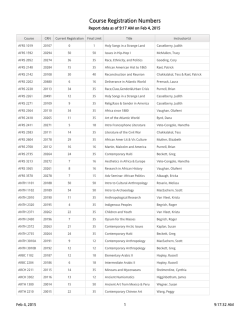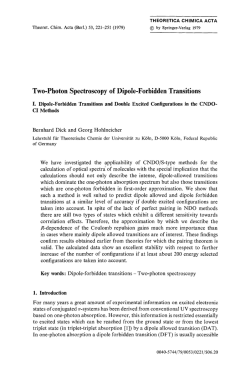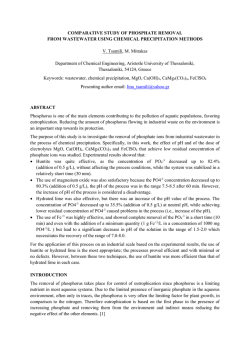
~SiMe3
Tetrahedron Letters No. 29, pp 2495 - 2496, 1977. Pergamon Press. printed in Great Britain. THE CARBONn INSERTION REACTIONS OF MIXED TERVALENT PHOSPHORUS-ORGANOSILICONREAGENTS D. A. Evans,* K. M. Hurst, L. K. Truesdale and J. M. Takacs Contribution No. 5593 from the Laboratorfes of Chemistry California Institute of Technology, Pasadena, California 91125 (Received in USA 1 Nay 1977; received in UI( for publication 8 June 1977) In conjunction with our general interest in the development of synthetic operations which 1 reverse the normal polar reactivity patterns of the carbonyl function, we have been focusing our attention on carbonyl derivatives which could serve as operational equivalents to the hypothetical carbanions 1 and 2.2,3 In this regard we have been engaged in the development of organosilicon reagents 2 containing potential carbanion-stabilizingfunctions, A, which will In principle, such carbonyl derivatives, upon undergo facile carbonyl addition (eq. 1). metalation, should serve as valuable carbon nucleophi.lesin organic synthesis. During the course of this study, a series of brief notes appeared on the reaction of tervalent phosphorus reagents & and G with saturated aldehydes and ketones (eq. 2) to give phosphonates k4 phosphonamidesz5 respectively (Method A). and A complementary method for converting aliphatic and aromatic aldehydes into Wsiloxyphosphonates (eq. 3) has been described in tl..: patent literature (Method B),6 8 R-C:- R -:CH2CH2C-R Rl\C=O / R2 8 R-C-H OSiR’3 + R’3SiA --c R-#-A (1) ~SiMe3 + Me3SiOPX2 & Rl-y-p2 % 2, X = 0-Alkyl Method A (2) Method B (3) RZO k, X = NEt2 RI\C=O QSiR3 + PX3 + R3SiCl & R1-F-f;X2 H 0 H/ 2495 No. 2496 29 The purpose of this connnunicationis to report our observations on the scope of these carbonyl addition processes with a,B-unsaturated ketones and aldehydes. Of particular interest in this study has been the regiochemistry (1,2 vs 1,4-addition) and probable mechanism of these addition processes, a point which has not been dealt with in previous studies (Scheme I). pSI$ RlCH=CH-_F-$X2 x Rz O R RICH=CHC-R2 + ymg X2fj-r-CH=C-R2 Method B 5 1 Three silicon-phosphorusreagents 5 were prepared for study. Dimethyl trimethylsilyl phosphite [TMSOP(OMe),land dimethyl triethylsilyl phosphite [TESOP(OMe)2]were 4b prepared by known procedures. Triethylsilyl N,N,N',N'-tetramethylphosphorodiamidite [TFSOP(NMe2)21was prepared from N,N,N',N'-tetramethylphosphorodiamido chloride7 and triethylsilanol in ether/triethylamine(bp 66-74"c, 0.02 mm; 55% yield).* The reactions of the mixed silicon-phosphorusreagents 2 (Method A) with a series of CT,&unsaturated aldehydes and ketones were carried out with one equivalent of each reagent either neat or in THF under an inert atmosphere. The aldehyde addition reactions generally proceeded at a convenient rate at ambient temperatureswhile ketonic substrates required heating. The complementary addition reac'ions employing the phosphite esters, PX.,,and chlorosilanes (Method B), 6 as described by Birnum, were carried out with stoichiometric quantities of each reagent, neat, at the indicated temperatures in sealed ampules (Table). Qualitatively, the relative reactivities of the tervalent phosphorus reagent, PX3, followed the general order: ROP(NMe2)2 >> ROPPh2 > (R0)3P (c.f. Entries 10-12). This trend is consistent with the relative nucleophilicities of 9 related phosphorus derivatives towards alkyl halides. The possibility that the 1,2 and 1,4adducts L and 8 might be interconverted thermally was eliminated by the following experiment: The crotonaldehyde 1,2 and 1,4-adducts (Entry 5, Table) were individually heated (200°c, 24 h), and no interconversionwas detected. The high thermal stability observed in this instance suggests that the 1,2:1,4-adductratios reported in the Table are a consequence of kinetic control during the addition process. From a mechanistic standpoint the two methods reported herein differ in that Method A involves intramolecular silicon transfer during t..eaddition pr0cess.l' Furthermore, we have determined that under the conditions employed for Method B, the mixed silicon phosphorus reagent 5 is not an intermediate. One rational mechanism for the 1,2-addition of the tervalent phosphorus-siliconreagent 5 to carbonyl substrates is illustrated in Scheme 11.10 In those cases where 1,4-addition is possible, several observations suggest that addition proceeds e the oxaphospholenesg (Method A) and 2 (Method B). First, the 2497 No. 29 a. Addttion Reactions of Mixed Phosphorus Reagents to Carbonyl Substrates (Scheme I).8 Entry Substrate PX3 (Method) Conditionsa 7.Yiel& Ratio (z:g) 1,2:1,4_addition 47~53 1 CH2 = CHCHO TMSOP(OMe), (A) 25", 12 h aa 2 CH2=CHCH0 (MeO)3P/TMSCl (B) 2S", 4 h JO > 99:l 3 CH2=CHCH0 TESOP(NMe2)2 (A) 00, l/4 & 90 > 99:l 4 CH2=CHCH0 Ph2PoMe/T& loo", l/2 h 5 CH3CH=CHCH0 TMSOP(OMe)2 (A) 550, 18 h 90 6 CH3CH=CHCH0 (MeO)3P/TkfSCl (B) 55", 3 h 62 > 99:l 7 CH3CH=CHCIIO TESOP(NMe2)2 (A) 00, l/2 fi 95 > 99:l 8 PhCH=CHCHO TESOP(NMe2)2 (A) O", l/2 $ 93 > 99:l 9 CH =CH!CH 2 3 SO", 6 h 88 < 1:YY 10 P CH2=CHCCH3 100°, 2 h 79 < 1:YY 11 P CH2=CHCCH3 0", l/2 hg 82 c 1:YY 12 P CH2=CHCCH3 (100) < 1:YY (B) (MeO)3P/TBSCl (B) Ph2POCH3/TESClg (B) loo", l/2 h < (100) 1:YY JS:25 sxcept where noted the reactions were carried out in the absence of solvent. ILyieldsreported are of distilled adducts. Yields in parenthesis were determined by nmr. In suchdcases distillation resulted in decomposition. qhe reaction was carried out 3 M in THF. -Available from Aldrich Chemical Company. olefin geometry of the 1,4-adducts$, R = H, Me (Entries 4, 9, 10, 12, Table), is exclusively i?,a possible consequence of the intervention of oxaphospholenes such as g and 2. Second, CT,B-unsaturated ketones locked in a transoid geometry such as cyclohexenone fail to undergo 9 detectable 1,4-addition. Finally, we have prepared the known oxaphospholene g (R = Me) 11 and have demonstrated that it undergoes a rapid exothermic reaction with trimethylchlorosilane to give the Z-phosphonate 8 (R = Me, X = OMe) in nuantitative yield. In conclusion, through a judicious choice of the phosphorus reagent one may achieve high regioselectivity for either 1,2 or 1,4-addition to a#-unsaturated aldehydes, and regiospecific l&-addition to methyl vinyl ketone and presumably to related enones. The general class of phosphorus-activatedCLefins 2 and 2 (Scheme I) should prove to be useful carbon nuoleophiles upon metalation. These studies are now in progress. 2498 No. 29 Scheme II Rl\,C=O + X2POSiMe3 1- __c .&Nm R1 R2 II 2 0 X2+ 4 8 CH2=CHCR S)SiMe3 I\_ 8, OSiMe3 We013P B. Research support from the National Science Foundation is gratefully acknowl- edged. We wish to thank J. Kouba for technical assistance in this project. REFERENCES 1. 2. 3. 4. 5. 6. 7. 8. 9. 10. 11. D.A. Evans and G.C. Andrews, Accounts Chem. Res., z, 147 (1974). For an excellent survey of acyl anionequivalents see O.W. Lever, Jr., Tetrahedron, 32, 1943 (1976). D.A. Evans, G.C. Andrews and B. Buckwalter, J. Am. Chem. Sot., 9-6,5560 (1974). (a) For a leading reference, see I.V. Konovalova, L.A. Burnaeva, N. Sh. Saifullina and A.N. Pudovik, J. Gen. Chem., USSR, 5, 17 (1976); (b) L.V. Nesterov et al., ibid. 41 2655 (1971). 2474 (1971); Z.S. Novikova, ibid., _, A.N. Pudovik, E.S. Batyeva and V.A. Al'fonsov, J. Gen. Chem., USSR, g, 921 (1975); A.N. Pudovik, E.S. Batyeva and V.A. Al'fonsov, ibid., 240 (1975). G.H. Birum and G.A. Richardson, U.S. Patent 3, 113: 139 (1963). H. Noth and H.-J. Vetter, Chem. Ber., 2, 1505 (1961). Satisfactory s:ectral and combustion analyses were obtained for all new compounds. R.G. Pearson, H. Sobel and J. Songstad, J. Am. Chem. Sot., 9&)-319 (1968); G. Aksnes and D. Aksnes, Acta Chem. Stand., l8, 38 (1964). Appropriate cross-over experiments testing this point will be detailed in a later publication. D. Gorenstein and F.W. Westheimer, J. Am. Chem. Sot., 92, 634 (1970).
© Copyright 2026
